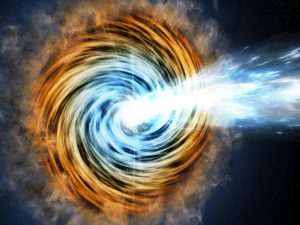The scientists have observed the source for a high-energy cosmic neutrino coming from outside our galaxy. The article in “Science” magazine describes the observational campaign and its results. Prof. Tomasz Bulik from the Astronomical Observatory of the University of Warsaw is one of the authors.
On 22nd September last year, the Ice Cube Neutrino Observatory at the South Pole detected a high energy neutrino with a likely cosmic origin. A single neutrino does not suffice to identify its source. Very soon after its detection telescopes working at different wavelengths of the electromagnetic spectrum started to observe the location it came from. Already 4 hours after the detection the HESS telescope located in Namibia started the observations. It was soon followed by VERITA telescope (Arizona, USA), which started observing 12 hours after the alert. Next day, the MAGIC telescope (Canary Islands) joined the campaign. These initial observations provided upper limits on the brightness of the source. The MAGIC telescope continued the monitoring campaign until 4th October, observing for a total of 13 hours. During these observations, the source brightened up and became clearly detectable.
The observations that were performed with the telescopes sensitive from the radio band all the way to the very high energy gamma-rays indicate that the source is the TXS 0506+056 galaxy, about 4 billion light-years away. The galaxy is a blazar, that is it hosts an accreting black hole which launches powerful jets of matter at speeds close to the speed of light. We observe blazars along the jet direction. Particles are accelerated to high energies in jets, however observing only gamma rays does not allow to distinguish if these are electrons, protons, or even nuclei. Fast protons collide with the particles of the interstellar gas creating pions, which in turn decay emitting neutrinos.
The discovery of gamma rays along with neutrinos is extremely exciting because their origin must be connected with the acceleration of cosmic rays. The origin of cosmic rays has been a puzzle for more than 100 years since their discovery. The observation of gamma as and neutrinos indicates that blazars host environments where cosmic rays are formed. This is the direct evidence for the existence of a cosmic proton accelerator. Moreover, it is another success of the multimessenger astronomy, a new branch of astrophysics which connects not only observations at different wavelengths, but also those with different types of radiation: electromagnetic waves, neutrinos, cosmic rays and gravitational waves.
The paper entitled „Multimessenger Observations of a flaring blazar coincident with high energy neutrino IceCube-170922A” that describes the observational campaign and its results has been published in Science on 13th July this year. Prof Tomasz Bulik from the Astronomical Observatory of the Universty of Warsaw is one of the authors.
Scientists from UW, UJ, CAMK, UNK, and IFJ take part in the HESS telescope operation and data analysis. A group from UŁ participates in the MAGIC telescope.




